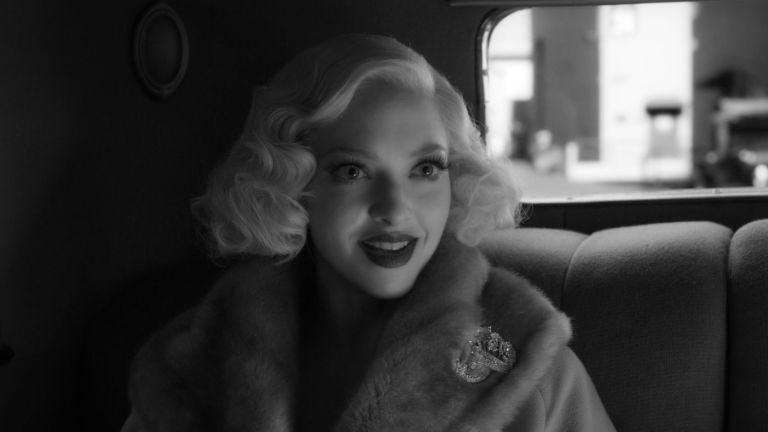Mank and Amanda Seyfried’s Quest to Save Marion Davies from Citizen Kane
Mank’s Amanda Seyfried talks about giving Marion Davies her voice, Brooklyn accent and all, and getting away from Citizen Kane’s hatchet job.

Amanda Seyfried is a fan of old school movies and classic Hollywood. Considering the Mank star has been acting since she was a teenager, this isn’t a surprise. In her mind it’s a prerequisite, something that comes with the territory: each young actor is obligated to “study film on the job” when starting out. So she’s seen Citizen Kane, of course, and knew the stories of Orson Welles’ masterpiece taking on newspaper baron William Randolph Hearst. And yet, even she was barely aware of Marion Davies, the once popular movie star from a century ago whose image Kane left like roadkill in its wake.
Perhaps that’s the dark magic of the movies though. Seyfried can recount early memories of Davies’ contemporaries like Charlie Chaplin, who loomed large in her childhood. But the shadows cast by these legends have a way of obscuring everything else.
“I grew up with a father who was obsessed with projectors and old movies,” Seyfried says over a Zoom call. “We have nitrate film still in our basement, and I can’t believe our house hasn’t blown up yet. I grew up surrounded by Charlie Chaplin, James Cagney, and Laurel and Hardy. I just watched everything with my dad… that was my childhood. And I still didn’t know about Marion Davies.”
To Seyfried, Davies was just a name, another glamorous Hollywood film star from the ‘30s who was renowned for her beauty and style—and like so many other women of that era, was overlooked for anything more. Yet after the early 21st century star was cast to play her 20th century counterpart in David Fincher’s Mank, Seyfried became astonished by a talent that’s been largely forgotten, and determined to do it justice.
“She’s effortless,” Seyfried says of Davies. “She is immensely watchable, really funny, and clearly for me, [a] really talented comedian. She’s got the timing all right. She’s like Goldie Hawn. She’s fantastic, and I don’t think she got the respect that she deserved.”
That frustration stems in part from how Davies came into the industry. Once a chorus girl who ran away from a Catholic convent education, Davies had a natural ability for Vaudeville comedy and Broadway theatricality, appearing as one of the Ziegfeld Follies girls while still a teenager. And it was as a Folly that she met William Randolph Hearst, the much, much older (and married) media tycoon who became enamored with Davies, and soon her suitor.
Says Seyfried, “I think a lot of people assume that it was just one of those situations, a May-December relationship with the billionaire man and the young woman. And it just wasn’t that. It might never have been that.”
It was, however, what brought Davies to Hollywood, with Hearst grooming her for stardom in first the silent era of the 1920s and then the early talkies of the ‘30s. It also simultaneously provided Marion with opportunities and obstacles. Her natural knack for comic timing was often mitigated by Hearst’s desire to see his mistress in respectable period fare: as Mary Tudor in When Knighthood was in Flower (1922) or as Marie Antoinette in a film MGM eventually made—without Davies, much to Hearst’s chagrin.
Many, including Seyfried, believe these career choices limited Davies’ potential, and hid her genuine talents. However, the bigger blow to her legacy was due to something entirely out of her hands: Orson Welles and (more painfully) screenwriter Herman J. Mankiewicz’s Citizen Kane. As a thinly veiled satire of Hearst—especially in Mankiewicz’s first draft—that film followed a fictional newspaper baron who becomes obsessed with a young entertainer played by Dorothy Comingore. Like Davies, Comingore’s Susan Alexander has a thick New York accent, but unlike Davies, Susan is a talentless singer who feels trapped and resentful of Kane’s possessiveness.
Says Seyfried, “A lot of people when they think of Marion, when they hear her name, they think of Susan Alexander. So that’s not helpful. It’s a myth. They’re very different careers.” For starters, Seyfried sees talent and incredibly hard work in Marion’s filmography, as well as a brutal intelligence that Seyfried knows was misunderstood. “It’s sad she has been misunderstood for so long, in a lot of ways,” she says. But that misunderstanding is in no small part because of how oblivious Susan Alexander is depicted in Kane.
It’s one of the biggest acts of betrayal in Golden Age Hollywood, and it’s a treachery at the heart of Mank’s drama. Seyfried plays Davies, thick Brooklyn accent and all, as a bon vivant. She’s the life of the party and lady love of Hearst (Charles Dance), whose old age is a seemingly endless party at his and Davies’ castle like home of San Simeon. There Marion and Hearst hold court, including with their favorite jester, screenwriter Herman “Mank” Mankiewicz (Gary Oldman).
It was Mank who had the idea to turn Hearst’s life into a source of drama and tragedy when meeting with Welles, and it was Mank who made the choice of depicting Charles Foster Kane’s lover as a lonely, self-absorbed neophyte imprisoned in his palace. It wasn’t the Marion whom Mankiewicz knew, which Mank demonstrates by showing an actress of scathing wit that’s every bit as quick as Mank’s. Yet that unflattering image of Marion was the one Mankiewicz felt compelled to give the public. He knew how to find a good story.
Perception, even among industry insiders, is everything. And those pressures are ones Seyfried is acutely aware of, particularly given how little they’ve changed in the hundred or so years that separate her from Davies.
“You always encounter people who want to tell you what to do and where to go and how to do it,” Seyfried says. “Agents, managers, publicists, you have these people that are meant to help you and guide you, and when done well, they do really well, and you have a good relationship with them.” In that sense, Seyfried doesn’t believe the industry has changed much at all from the days of Hearst demanding Davies appear a certain way, which Seyfried believes “put her in a box [and] was partially why her career petered out.”
Says Seyfried, “There have been times when I have argued over my own career path at one time time or another, and also the powers that be in Hollywood sometimes want to put you in a box. It’s really hard to push through that in the beginning of your career, and you just have to be strong-willed and know what you want. Luckily I didn’t get trapped at any point too much, but it’s hard, especially to be a woman and feel like you have a voice and that people actually want to listen to you.”
The way Seyfried sees it, there are things about the industry that weren’t going to change for decades or more, “maybe a century, sadly.” And there remain other challenges as well. Citizen Kane might make Davies’ experience with being misunderstood singular, but Seyfried is all too aware that “anybody who’s famous is misunderstood immediately because nobody can ever know the real person, every dimension of somebody.”
Seyfried came to understand those similarities, and appreciate Marion’s full talents as soon as she began preparation for Mank. That process included reading Davies’ autobiography, The Times We Had: Life with William Randolph Hearst—a series of recollections as much about Davies and Hearst’s mythic parties at San Simeon as her film career—as well as diving into old movies like Cain and Mabel (1936). But at the end of the day, it always boiled down to finding Marion’s voice as imagined by Fincher’s singular eye, and his father Jack Fincher’s painstakingly authentic screenplay.
Coming to work with David for the first time, Seyfried was obviously aware of the stories about him shooting many, many takes for every scene—Mank even apparently set a record for the director during a climactic sequence at a Hearst party. And Seyfreid has a story of her own. It involves Mank’s recreation of Davies’ infamous exit from the MGM lot (a reaction to the studio passing her over for Marie Antoinette), which itself was a reshoot that included Seyfried’s Davies driving away with a full size house on a flatbed, dozens upon dozens of times.
“I don’t know,” Seyfried confesses when we ask exactly how many takes she filmed that scene. “I will tell you, I definitely fell asleep a lot in the back of that car. Many, many naps.”
However, what surprised Seyfried most about being inside Fincher’s process is that his penchant for multiple takes is the thing that gets most publicized.
“I think it’s surprising to me that he’s not immediately known for other things, that it’s the takes,” says Seyfried. “I feel like enough people have spoken about him, about working with him, that I think it’s still funny that people are still hanging onto the multiple takes thing. Having worked with him, I don’t feel like that really characterizes him at all.”
Instead she thinks what does characterize him is the warmth and freedom he gives actors to play.
“What I really loved finding out was that he’s incredibly respectful of his actors because we are the people embodying his characters, and we all need to feel supported… He gives us huge space to evolve and grow within the scene or the work, or the moments, even.”
It also gave Seyfried the space she needed to luxuriate in the language crafted by Jack, and his sometimes old-fashioned dialogue. Indeed, before writing Citizen Kane, Mankiewicz cut his teeth on Hollywood comedies in the early sound era, helping write scenarios and gags for the Marx Brothers around the same time that screwball comedy was being invented. And in Mank, Mankiewicz and Davies’ scenes especially crackle with rapid fire exchanges.
“We have a spark,” Seyfried says of her and Oldman’s scenes. “Gary and I have worked together before and we get each other. I think we’re perfectly matched to play anybody if we’re doing it together. I think we work very similarly and that spark you hopefully feel when you’re watching the scenes with us is actually based in reality.”
Yet at the same time, Seyfried credits Jack’s screenplay, which she compares to being “like cake for us,” as a chance to imagine what it might’ve been like if Mankiewicz could have ever written a comedy for Davies.
“If the powers that be could have made that happen, I think that they would have made such wonderful music together,” Seyfried reflects. “They’re cut from the same cloth. The chemistry that’s there was, I do believe, very authentic… He clearly had deep feelings for her, platonic feelings for her, a deep respect. And I think she felt the same for him. It would have been amazing to see that, to see him write for her.”
With Mank, it’s as if he finally has. And in so doing, Seyfried has helped Davies take a spotlight free from Kane’s deep shadows.Mank premieres on Netflix on Friday, Dec. 4.


